Today was the final day for work or the formative coffee cup collage. Students who finished early were asked to research the animal of their choice for the summative assessment. Students were told that the animal selected should be part of a species that is directly effected by poor recycling efforts. The selected animal photos were then emailed directly to me at: cassidn@dearbornschools.org and printed out in class. The remaining students will be given the opportunity to complete this requirement on Monday after the break.
Category: Blogs
11.24.15
Posted by Niki Cassidy On November 24, 2015
Unit 4- Collage Painting with paper
Posted by Niki Cassidy On November 18, 2015
Unit 4 will focus on collage as an artistic medium. We will be using the work and style of Megan Coyle, a renowned collage artist, as inspiration for our final projects in this unit. Her work is shown below:

Artwork by Megan Coyle

Artwork by Megan Coyle
The first formative assessment will ask students to select colors, textures, and shades of chosen colors to render a still life image selected by the teacher. This formative is designed to teach students the techniques and management of materials required on their summative projects. It will also assist me in identifying areas in need of further instruction.

Formative Assessment Example

Formative Assessment Example

Formative Assessment Example
The summative assessment will ask students to select an animal of their choice to carefully render using this technique.

Summative Assessment Example

Example of Summative Assessment

Example of Summative Assessment
The rubric and standards of success will be included in the next post.
Unit 3-Color Theory Introduction
Posted by Niki Cassidy On October 28, 2015
For unit 3 we are focusing on color theory. This unit will review basic color mixing using the three primary colors to create the secondary and tertiary colors.
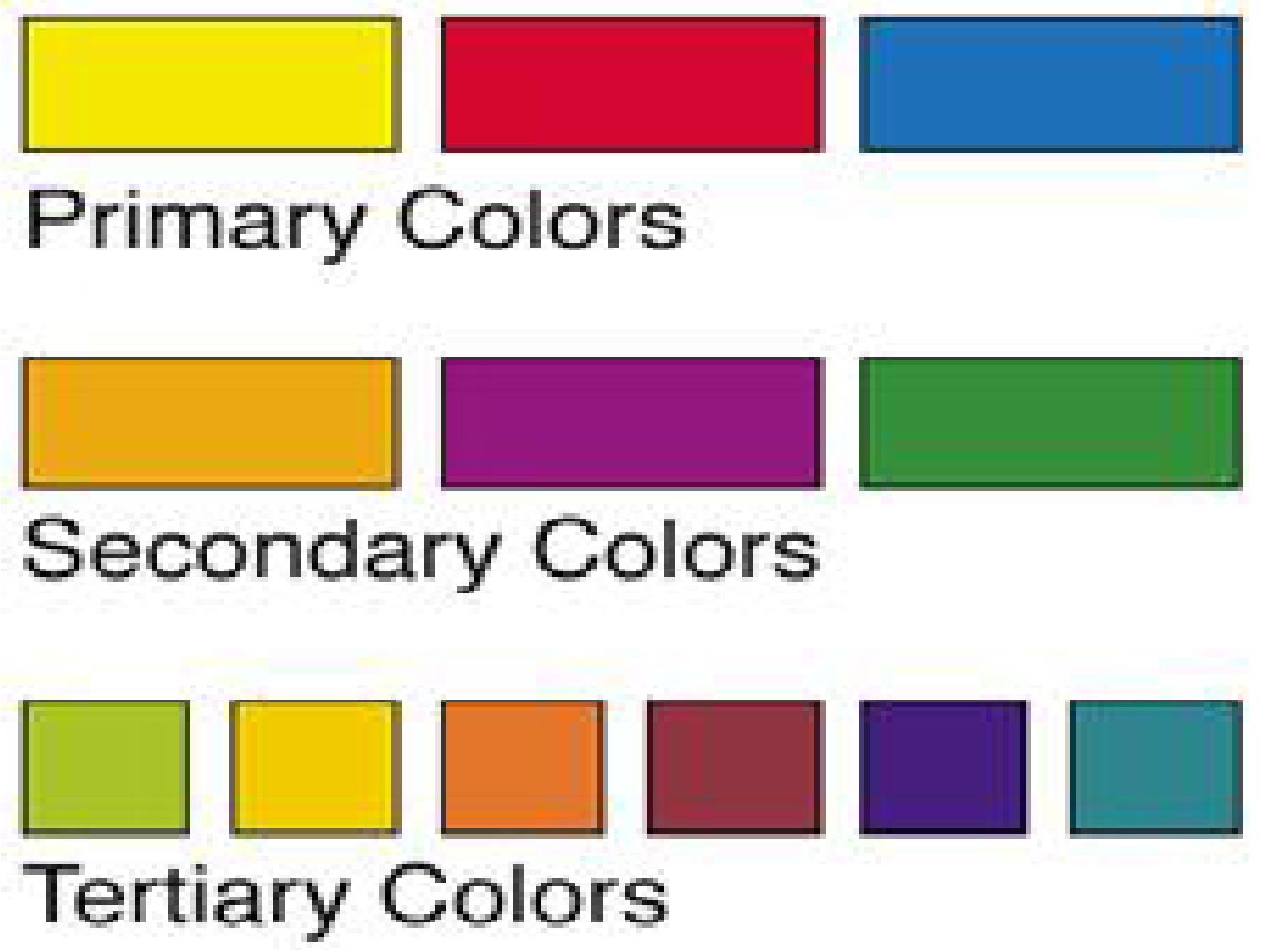
Students will create a value scale of tints, shades, tones of a single color in 20% increments.

Student will use this experience to develop a summative assessment that clearly demonstrates their knowledge and understanding of color mixing and expressive qualities. Each student will create an expressive color ‘wheel’ using their unique creativity and interests. Samples of expressive color ‘wheels’ include but are not limited to the following:




Students are encouraged to search the internet and their immediate environment for inspiration but are discouraged from copying directly.
Parent Conferences
Posted by Niki Cassidy On October 27, 2015
Parent-Teacher Conferences are tonight and Thursday in the DHS cafeteria from 4:00 PM to 7:00 PM.
Report cards will be available for pickup.
If you cannot attend conferences, you are always welcome to email me at: Cassidn@dearbornschools.org
Value-Still Life
Posted by Niki Cassidy On October 21, 2015
The summative assessment for our unit on value requires students to select a drawing medium of their choice (charcoal, pencil, or watercolor) and create an image based on a still life located in the center of their table. Students were advise d to take a photo of the still life to use as further reference. ‘
sample: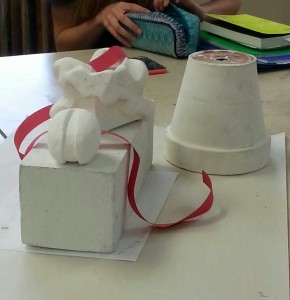
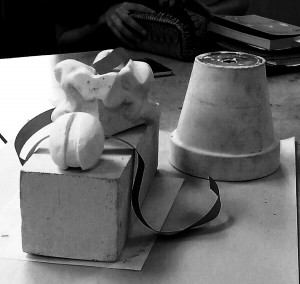
Students were then asked: How should this be graded in terms of effort, line/shape, value, color, and creativity.
As a group each class provided answers and developed the rubric for this summative assignment.
|
Objective: Using the medium of your choice, create a still life drawing that demonstrates your understanding of value and its application in the creative process. Assignment: Value-White Still Life with Ribbon |
|||||||
| Student Name | Class | ||||||
| Date | |||||||
| 4 | 3 | 2 | 1 | 0 | Student | Teacher | |
|
Value(4)
|
Value-Student has independently created an image that is an exceptional drawing that incorporates 4 or more values using a student selected medium, visual unity, and allows for clear light source.
|
Value- Finished image is an interesting drawing that incorporates at least 3 values, visual unity, and allows for clear light source.
|
Value – Finished image is a design that includes at least 2 allowing for slight contrast, and little unity.
|
Work is less than 80% complete |
Student does not demonstrate proficiency in any of the criteria described or assignment is not turned in |
||
|
Creativity (8) Color
|
Creativity/color – Student has included details to add interest and included careful rendering of shadows. |
Creativity/color – Student has include some details to add interest and most shadow and shading is accurate.
|
Creativity/color – Details are not based on still life or do not add to the image. Shadows are in accurate and shading is not based on still life.
|
. Work is less than 80% complete | Same as above | ||
| line (4) | Line/Shape Finished shows evidence of student’s mastery understanding shape, as evidenced by clear separation of objects and background resulting in strong contrast. | Line/ Shape -Finished image shows student understanding shape, as evidence as evidenced by objects that are easily identified. There are some areas of contrast. | Line/Shape Finished image shows students limited understanding of shape as evidenced inaccurate drawing of objects when compared to still life/ photo resulting little or no contrast. | Work is less than 80% complete | Same as above | ||
|
Effort (4) Participation & Effort |
Class participation – Student used time wisely during class periods, demonstrating exemplary classroom behavior, respect of materials, teacher and peers Effort – Student took time to develop an exceptional idea; turned in completed assignment on due date, excellent use of class time Craftsmanship – Work is skillfully neat, clean and has been completed following all of the assignment expectations. |
Class participation – Student used time wisely during class periods, demonstrated appropriated classroom behavior, respected materials, teacher and peers Effort – Student took time to develop idea; turned in assignment on due date, good use of class time Craftsmanship -Work is neat, clean and has been completed following most of the assignment expectations. |
Class participation – Student did not use time wisely during class periods, demonstrated inappropriate classroom behavior, did not always respected materials, teacher and peers Effort – Student did not develop idea; turned in assignment past due date, did not always use of class time well Craftsmanship – Work has been completed following some of the assignment expectations. |
Not evident | Same as above | ||
Still life Drawing (Value)
Posted by Niki Cassidy On October 20, 2015
Today we began our second major project. After studying the effects of light on objects and creating the illusion of form from a two dimensional shape, students are ready to take on the all white still life. Before beginning the final project students have been given numerous formative assessments designed to strengthen their observational skills and to practice tonal and linear rendering.
Here is a quick review of some of the methods used to render objects: How to draw with different rendering techniques
EXPLORE WITH 4 DIFFERENT RENDERING TECHNIQUES
I will discuss four different techniques you can use to make and interesting object or to help you loosen up and think outside of the box.
The first thing you can do is to create a tonal value strip on a separate piece of paper of each of these techniques. This will help you get a hang of using them and to practise going from dark to light on the tonal spectrum.
The four techniques I will be discussing are smooth, scribble, hatching and cross-hatching and pointillism. I hope that after you read this that you will find new inspiration to use these techniques in your drawings.
 |
| Smooth |
Smooth
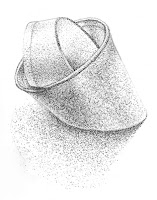 |
| Pointillism (stippling) |
Pointillism
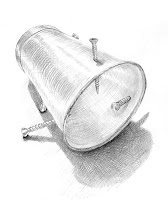 |
| Hatching & Cross-hatching |
Hatching & cross-hatching
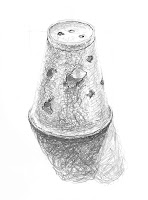 |
| Scribble |
Scribble
Scribble is literally scribbling like you did when you were a child. The best way to go about when scribbling is to keep you wrist relaxed. You can experiment with the angle at which you are holding your pencil to achieve a different mark as you draw. Vary the pressure at which you draw and you can overlap your scribbles to get a nice tonal spectrum in your drawing. Scribble is a great rendering technique for textured objects like the surface or a carpet or tennis ball.
Some of these rendering techniques might sound strange but they work great when you want to apply texture and they are also fun to do. I recommend that you try all these techniques and most of all enjoy while you are doing it.
Revisiting 1 Pt. Perspective
Posted by Niki Cassidy On October 18, 2015
During our first unit we studied 1 Pt. Perspective. This post is intended to revisit the concepts and provide links for further practice.
Understanding of 1 Pt. Perspective is an important part of creating 2 dimensional artworks with a sense of distance. It aids in creating the illusion of space.
One Point Perspective Drawing Tutorial – YouTube
Welcome to iBlog
Posted by Niki Cassidy On October 18, 2015
Welcome to iBlog Teacher Websites Sites. This is your brand new classroom website. There are some things you should do to get started. Hopefully you have been following the Getting Started Tutorials and Step Sheets.
It is important that you edit your profile so that you can choose your school and grade level as this will help parents and students find your website. Look for the link in the upper right when you are logged in.
Here are some resources to help you with iBlog:
- Getting Started Tutorials
- Using Plugins (Calendar, iPhone App, eNewsletter, and more)
- Support Tutorials (General iBlog tips and tricks)
- Discover WordPress (The software that runs iBlog)